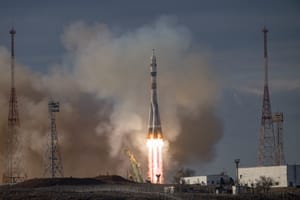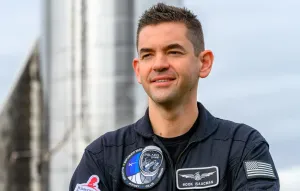
Mar 25, 2024
Crew and Cargo arrive at the International Space Station
Over the weekend, two vehicles from two different sides of the world arrived at the International Space Station. The first to arrive was a SpaceX Cargo Dragon V2 with the second, following by a few days, being Soyuz MS-25 carrying three astronauts.
After spending almost two days catching up to the International Space Station, Cargo Dragon V2 C209 docked to the International Space Station via the Zenith port of the Harmony module, the Zenith port is located on top of the module and faces space. The spacecraft is carrying 2,841 kilograms of cargo for the crew onboard. Cargo Dragon C209 lifted off from Florida back on the 21st, for more about CRS-30 click here.

A few hours later, at 12:36 pm Universal Coordinated Time, the Soyuz MS-25 mission lifted off from the Baikonur Cosmodrome, located in Kazakhstan, atop of a Soyuz 2.1a rocket. Aboard the rocket were Oleg Novitskiy, Marina Vasilevskaya, and Tracy Caldwell-Dyson. Novitsky and Vasilevskaya will contribute to research as part of Expedition 70, with Caldwell-Dyson staying into Expedition 71. Expeditions are six-month periods aboard the International Space Station.
At approximately 15:05 pm, Universal Coordinated Time, on the 25th, the Soyuz MS-25 spacecraft docked at the nadir port of the Prichal module. The rendezvous to the station took almost two days instead of the usual six hours due to an aborted launch on the 21st. At the time of writing crews aboard the International Space Station and Soyuz MS-25 are preparing to open the hatch in a few hours.
With Soyuz MS-25 now docked, Oleg Novitskiy and Marina Vasilevskaya will spend approximately twelve days aboard the International Space Station before returning. They will return in the Soyuz MS-24 spacecraft with Loral O'Hara.

This is because Roscosmos plans to have Oleg Kononenko and Nikolai Chub aboard the station for almost an entire year. Tracy Caldwell-Dyson will return to Earth in late September aboard the Soyuz MS-25 spacecraft with Kononenko and Chub.
Who's onboard Soyuz MS-25?

Oleg Novitskiy is the Commander of the Soyuz MS-25 mission and is making his fourth trip to space having previously flown on the Soyuz TMA-06M, Soyuz MS-03, and Soyuz MS-18 missions previously. Novitsky was selected as a cosmonaut in 2006 and first flew in 2012. He has also been awarded the award 'Hero of the Russian Federation'.
Oleg Novitskiy has currently spent a total of five-hundred and thirty-one days in space over his past three missions.

Marina Vasilevskaya is one of Soyuz MS-25's Flight Engineers and is making her first trip to space. She will also become the first woman from Belarus to fly to space since it formed as a country, as Belarusians had flown to space as part of the space program of the Union of Soviet Socialist Republics.
Marina Vasilevskaya was selected as a cosmonaut in May 2023 having previously worked as a flight instructor for Belavia.

Tracy Caldwell-Dyson is also one of Soyuz MS-25's Flight Engineers and is making her third trip to space having previously flown on the STS-118 and Soyuz TMA-18 missions. Caldwell-Dyson was selected as an astronaut in 1998 and first flew in 2007 aboard Space Shuttle Endeavour. She also graduated with a Bachelor of Science from California State University as well as graduating from the University of California with a Master of Science.
Tracy Caldwell-Dyson has spent almost one-hundred and eighty-nine days in space over her past two missions.
What is the Soyuz spacecraft?
The Soyuz spacecraft consists of three modules; the orbital module, the descent module, and the instrumentation and service module. The orbital module is used to give the crew extra space once on orbit and to store cargo. The descent module is where the crew are during launch and landing is the only part of the spacecraft that survives re-entry into Earth’s atmosphere. The instrumentation and service module is where the spacecraft's main engines are as well as its fuel. The solar panels to generate power for the spacecraft are also attached to the instrumentation and service module.



